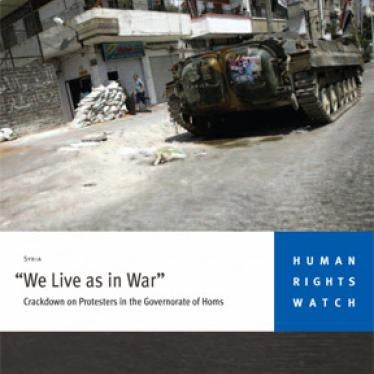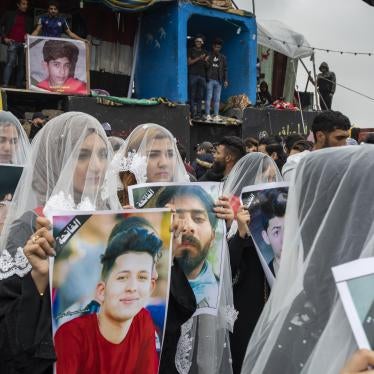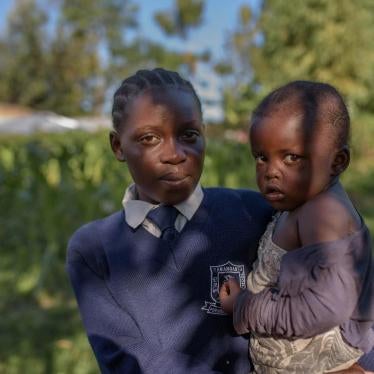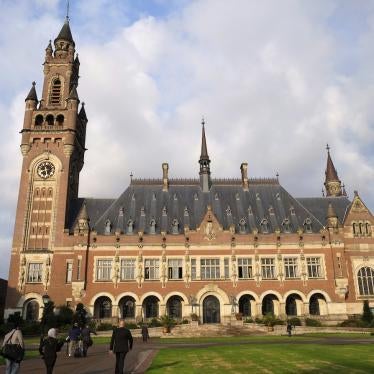(New York) – Accounts from witnesses reveal significant destruction and a large number of deaths and injuries of civilians in Syria’s bombardment of the city of Idlib, Human Rights Watch said today. On the anniversary of the Syrian uprising, Human Rights Watch urged Russia and China to agree to a UN Security Council resolution calling on Syria to halt the indiscriminate attacks on cities and demand access for humanitarian workers, journalists, and human rights monitors.
Idlib is the latest opposition stronghold to come under attack by the Syrian security forces attempting to rout the armed opposition. Syrian activists have compiled a list of 114 civilians killed since the current assault there, which began on March 10, 2012. Five witnesses, including three foreign correspondents, gave separate accounts to Human Rights Watch that government forces used large-caliber machine-guns, tanks, and mortars to fire indiscriminately at buildings and people in the street. After they entered Idlib, government forces detained people in house-to-house searches, looted buildings, and burned down houses, the witnesses said.
“City after city, town after town, Syria’s security forces are using their scorched earth methods while the Security Council’s hands remain tied by Russia and China,” said Sarah Leah Whitson, Middle East director at Human Rights Watch. “One year on, the Security Council should finally stand together and send a clear message to Assad that these attacks should end.”
The attacks on Idlib follow months of atrocities that both the United Nation’s Commission of Inquiry and the UN High Commissioner for Human Rights have described as crimes against humanity.
The large-scale military operation on Idlib on March 10 began at around 5 a.m.
“Michael,” an international journalist who was in the city, told Human Rights Watch:
The army started shelling the city in the morning with tanks and continued until the night. They were shelling everywhere. In the morning we could hear shells every two minutes. There was a short pause in the middle of the day before they started again. They were not shelling anything in particular. They were just trying to scare the population. The rebels were trying to fight, but it was impossible. After the shelling, the army started to move into the city.
“Maria,” another international journalist who was there that day, said that when the army opened fire from an armored personnel carrier on a building close to her, she ran to help people who had been wounded:
[After I heard about the attack] I ran to the building with a group of Syrians to help the people there. Some of the Syrians running to the building had weapons and cell-phones, but they were not taking active part in the fighting. There was a helicopter flying above us and it seems like the attack was well coordinated. Just before I reached the building – I was about 10 meters away – the government forces attacked again. It seems like they were shooting from the gun on an armored personnel carrier. If they had been shooting with anything bigger I would have been dead.
There were no weapons in the building and, although there was fighting in the vicinity, nobody had been shooting from that building. They were just attacking places where they could see groups of people, not caring at all whether the people were actually part of the fighting.
Maria, who like some of the others interviewed asked that her name not be used for fear of reprisals, told Human Rights Watch that at least five people were wounded and two killed in that attack.
Government forces also used mortars during the attack on the city. “Wasim,” an Idlib resident, described to Human Rights Watch what he saw when he went to a building on Ajama street in the northwestern part of the city that had been attacked around 6 a.m. on March 10:
Half of the building was destroyed. Three children – two girls and one boy – and their father had been killed. One of the girls had fallen from the building so she was lying in the street. The other members of the family were injured as well. It looked like the building had been hit from the roof. There was no particular reason for the army to attack this building. They just shot at everything. They are crazy. They have no particular targets.
“Hassan,” a journalist with significant experience working in war zones, told Human Rights Watch that one of the people extracting the wounded and killed from the building on Ajama street brought him remnants of the shell used to attack the building. Hassan identified the remnant as a mortar.
Another international journalist, who was just outside the city, said that shelling was continuing on March 12, and to a lesser degree on March 13.
Many of the wounded and killed were brought to a hospital in the old city, which was quickly overwhelmed by the number of casualties. Michael told Human Rights Watch:
At least 20 killed people were brought to the hospital the first day. There were more the second day – at least 30. The third day was terrifying. I don’t think anybody was keeping lists at that point. Wounded people kept arriving all the time. Medical personnel were trying to revive and attend to the wounded on the floors in the corridors because there was no space. Doctors were doing surgery without the proper equipment. They were doing their best, but they were really exhausted.
Hassan described the same hospital in similar terms:
The hospital was in total chaos. They couldn’t cope with the number of killed and injured. The dead were buried right away in a nearby park. But by Sunday [March 11] they had run out of space in the park and the park and school behind it were also being attacked so they had to bury the dead wherever they could.
Four witnesses among those Human Rights Watch interviewed who visited the hospital during the onslaught said that many of the killed and injured had clearly not taken part in any fighting. Michael told Human Rights Watch:
I would say that about half of the casualties were clearly civilians. There were women, children and elderly among them. Most of the civilians were wounded or killed because of shelling.
As government forces moved in to occupy areas of the city, they frequently looted shops and apartments, and deliberately burned down houses of suspected activists, the witnesses said. Wasim told Human Rights Watch that after he left the city on March 12, his father called him to tell him that the forces had destroyed many of the shops in their street and that they had torched the building on the opposite side of the street.
Another Idlib resident, “Mustafa,” told Human Rights Watch:
I have a list of almost 30 houses that have been burned down. At least some of them belonged to activists. On certain streets all the stores and shops have been looted. They even took the safe from some of the stores.
Government forces also detained scores of people during the offensive, both in Idlib and in surrounding towns. Some were released, while others are still in detention.
The witnesses interviewed by Human Rights Watch said that it is very difficult for people to leave the city as the highway encircling Idlib, forming a belt around the city, is controlled by the Syrian army. Landmines planted by government forces along the border with Turkey have made it even more difficult for people to flee the government’s onslaught. Hassan estimated that 85 percent of Idlib’s population is still in the city.
“The army controls the highway,” Hassan said. “The only way to get out is to sneak through the olive trees at night and try to cross the highway without the army noticing.”
Mustafa said that he had walked through fields in the dark for 15 kilometers to get out of the city.
The witnesses told Human Rights Watch that city residents had been killed by sporadic shelling and sniper fire before the March 10 offensive, but on a smaller scale.
One year after the uprising began in Syria, security forces have killed at least 8,000 civilians according to lists compiled by local activists. Vetoes by Russia and China have prevented the Security Council from taking any action on Syria despite evidence that crimes against humanity are being committed.
The UN secretary-general’s special envoy, Kofi Annan, will brief the Security Council on his efforts on March 16. Human Rights Watch urged Russia and China to support a United Nations Security Council resolution that would give Annan’s efforts the strongest possible backing as well as demanding that the Syrian government end the indiscriminate shelling of cities and allow access to affected areas for humanitarian workers, journalists, and human rights monitors. The resolution should also provide for targeted sanctions against officials involved in the abuse and an embargo on arms delivery to the Syrian government, and refer the situation in Syria to the International Criminal Court (ICC).
The UN High Commissioner for Human Rights has, on multiple occasions, recommended that the Security Council refer the situation to the court. Similarly, a growing number and wide range of countries have voiced their support for an ICC referral. On March 13, during a session at the UN Human Rights Council, Austria delivered a cross-regional statement on behalf of 13 countries supporting the High Commissioner’s call for a referral.
Human Rights Watch urged others to join the mounting calls for accountability by supporting a referral to the ICC as the forum most capable of effectively investigating and prosecuting those bearing the greatest responsibility for abuses in Syria.







